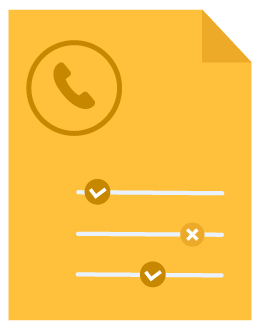10 Cold Calling Best Practices That Close Deals


Stuart Bontrager
This post was originally published in August 2018 and has been updated for accuracy and comprehensiveness.
Any SDR knows, as soon as they start a cold call, the timer has begun on their window of opportunity. You have maybe thirty seconds with a company to merit a three-minute conversation with a decision-maker and ultimately set an appointment with sales for 30 minutes. Simply put, there’s little room for error or hesitation.
As a result, EBQ has established our framework to ensure our SDRs have the tools to confidently navigate the challenges of cold calling. We can help you do the same. We’ve compiled a list of our ten well-proven cold-calling best practices that set sales appointments and improve cold-calling success rates.

Download the Cold Calling Best Practices Checklist
Drive efficient pipeline growth with our tips to engage prospects and direct the conversation to a close.
10 Cold Calling Best Practices That Close Deals
1. Be Comfortable, Confident, and Prepared
There’s rarely a time when making an initial cold call isn’t stressful – time and a lack of rapport with your prospect are instantly against you. We can all agree it’s only natural to be nervous when cold calling. Even veteran SDRs can experience some stage fright before making that first dial. Trust us, the more you agonize over the call and put it off, the more anxious you can become.
In these situations, the best thing you can do for yourself is to be prepared before you start dialing. Having confidence in your abilities will, in turn, help you be more calm, comfortable, and competent in a cold-calling situation.
A critical part of being prepared and feeling comfortable is understanding your persona and how to speak in their language. Always work towards learning more about their specific industry and the value of your offering.
Additionally, understanding how your company’s closing process works and visualizing how you’re going to set the appointment beforehand will help you more confidently navigate a call with a stranger.
2. Dials Draw Attention, Calls Drive Momentum
It might feel like an achievement to say “I made 100 dials today,” but what did you actually accomplish? What tangible progress did you make with a prospect? We hate to be the bearers of bad news, but a dial is only a touch; a call is a pursuit of an established goal.
That’s why getting something out of every call is important. It’s the responsibility of the SDR to ensure that every call always has two things – genuine communication and genuine substance to facilitate progress. You need to have an ongoing dialog with your prospects, not just dial in and read a script.
This isn’t to say that applying a touch to a contact – essentially leaving a fingerprint to stay top-of-mind – has little value. Even leaving an email, a voicemail, or having a conversation with an administrative assistant will increase your chances of setting an appointment.
That said, your team shouldn’t become complacent with just leaving fingerprints – it’s the exact mindset that can lead to an SDR being satisfied with a 100-dial day. Foster connection and generate value from every call to facilitate new conversations that will generate momentum.
3. Ensure Every Cold Call Is Done In Pursuit of Your Goal
When cold-calling, you want to be sure that every dial you make is done with purpose and that each conversation you have keeps you moving along the path toward your goal. Make sure you have answers ready for the prospect’s questions. Ensure you are knowledgeable of the prospect’s pain points and how your solution addresses them. If the prospect wants you to send some information, try to get them to agree to an appointment before you send it to them.
With every stage in the sales pipeline, you want to think pragmatically about how you can continue to your leads further downstream in the process in the best, most advantageous way possible. That said, you should remember that sales development and sales are not one and the same. You’re not trying to sell the offering to your prospect. You’re trying to nurture them, build a rapport with them, understand their hesitations, and work with them in order to move them along to the next step. That’s where your salespeople come in and do what they do best – close the deal.
This mindset is built on the idea of professional persistence and pragmatism. Put succinctly, One rule of thumb we abide by at EBQ is the Universal 3 No Rule. It states that after you receive three “No’s” or three points of resistance, then it’s clear that your prospect has a closed mind on what you’re offering; you should therefore move on to focus your efforts on another potential prospect.
4. You’re a Human, So Act Like It When Cold-Calling Your Prospect
Between calling and closing, there’s connecting. Building trust is essential to success in the incredibly competitive SDR world – so creating a human connection and establishing rapport is essential. The market is oversaturated with script-reading telemarketers who don’t dedicate the care and attention that’s required to legitimately maintain a natural and valuable conversation.
Think about it, you wouldn’t phone in a call to your friends or family just to read a bland, uncompelling script word for word. So why should you treat a prospect any differently? Always interact with your prospect like you would with anyone else.
You should always match the tone and energy of the person with whom you’re speaking. For example, if the person who answered your call was very dry and to the point, you’re not going to want to come across as being overly animated or talkative.
Sales Pro Tip: Some companies choose to take the easy road when it comes to sales development and incorporate sales tools like Sales 2.0 and autodialers into their operation. EBQ has found that those automatic tools clearly remove a critical piece of the appointment-setting process: genuine human interaction.
Before anyone chooses to use these tools in their sales and appointment-setting efforts, we strongly advise that they understand the clear trade-off of quality interactions that they will likely experience. SDRs are far more effective at securing appointments due to their nurturing and investigation skills – and simply because they’re human. We especially advise against going down this path for products with a higher average selling price.
5. Listen to the Conversation You are Having
There is no faster way to make prospects feel like you’re phoning it in than reading your cold-calling scripts verbatim. It’s a waste of time for you and your prospects. Unless you have superior acting skills, it will quickly become apparent to your prospects that you sound like you are speaking at them, instead of with them. SDRs can sink or swim by their ability to communicate, build rapport, and establish trust, so following your cold-calling scripts to the letter isn’t the way to do that. Instead, build rapport by focusing on maintaining a natural, fluid, human conversation that works to foster a connection with the person on the other side of the call.
In addition to how you communicate, be mindful of how you handle the conversation. There may be questions you’re dying to ask – questions that could yield critical information to feed to your sales team. It’s tempting, but you shouldn’t do it if it means running the risk of dominating the conversation or dictating its direction too much.
Just trust the process. Give the prospect ample opportunity to speak and ask questions. If you aren’t able to get your questions answered but you can set up a meeting, your sales team will be able to fill in the gaps further downstream.

Download the Cold Calling Best Practices Checklist
Drive efficient pipeline growth with our tips to engage prospects and direct the conversation to a close.
6. Understand Your Prospect’s Pain Points, How They See Value
It’s just a fact – different individuals will have different focuses and perceptions of value at a company depending on their position. For example, if you’re speaking with a company’s low-level contacts, they will likely appreciate the more technical aspects of your offering. On the other hand,an individual who is a VP or part of the company’s C-suite in some fashion will far more likely be more concerned with the value your offering will provide to the business, the probable ROI you can envision, and how your offering will specifically contribute to their bottom line. Because these different individuals have different ideas of value, their pain points will be different as well.
Consider it like you are fishing – different fish require different lures in order to be caught. What entices one individual towards your offering is not foolproof – it won’t work for everyone else. You need to be mindful of formulating a strategy that is individually tailored to your unique prospect.
This means regularly highlighting their relevant pain points throughout the call and reminding them why this call is uniquely important to them. If you find that things clearly aren’t resonating with your prospect as you’re discussing their pain points, swap lures and cast again.
7. Make Your Offering the Solution to Their Problem
Deals develop from identifying problems. It doesn’t matter if your offering is “innovative” or “industry-leading” or has a laundry list of features; it’s about what issues it can solve.
With this in mind, don’t get caught up in the bells and whistles of your solution when the prospect is only interested in knowing what utility your offering has in resolving their problems. It can give the impression that your focus is more on selling your company’s offering as a solution, and less on how it can actually provide any problem-solving value to the prospect.
Instead, when explaining your offering to a prospect, frame it as a solution to their unique problem, a cure for their specific ails. Take the time to genuinely verse yourself in the prospect’s biggest problems and unique pain points, then begin to form the conversation around laying out how your offering can address and resolve a prospect’s biggest issues in a way that really resonates with them.
8. Be Open to Questions from Prospects – They’re Not A Bad Sign
Much like making your initial cold call, it can be stressful to suddenly find yourself fielding multiple questions from a prospect. You may start to feel like you’re losing control over the conversation. This isn’t the case. If you did your homework, you should be confident in your ability to provide the prospect with informed answers. Just remember to be comfortable and listen carefully to the questions they’re asking.
Need one more reason why you shouldn’t shy away from prospect questions? If the prospect is asking questions at all – that’s already a clear form of progress. By providing the prospect the opportunity to ask questions, it shows they clearly have some level of interest in your offering. What’s more, giving them the space to speak openly and at length about their company can help you understand what they really need and determine whether they are the right fit for your offering at all. Take every prospect question as an opportunity to learn something new about them.
9. Set an Appointment, Stay on the Call
Just because you’ve successfully set an appointment doesn’t mean your job is done – don’t leave the call. Now is the time to verify the quality of your prospect-turned-lead.
Take the necessary time and effort to work through your remaining discovery questions to more accurately determine whether the lead is a good fit or a bad one. If an individual can satisfy all of your discovery questions, it’s more likely that they could be a good lead. If you find yourself asking a lot of discovery questions that they don’t have answers to, they may not be a good fit for your business. Even so, that’s still valuable information – and you have it because you stayed on the call.
10. Turn The Call into an Opportunity to Cross-Sell
As you take the time to listen to your prospects and build a relationship with them, you may come to find that the prospect isn’t interested or just isn’t a good fit for your particular offering. In fact, depending on the quality of your database, it’s quite possible that many of the prospects you call will not be the right fit for your solution. It’s not the end of the world. In fact, if your company provides a variety of products or services, this is the perfect opportunity to cross-sell other offerings.
After all, they weren’t a good fit for your initial offering, but they may have a need for another one of your company’s offerings that are handled by other SDRs. In this situation, it’s an EBQ best practice (and should be one of yours too) to not pitch them the product, but instead figure out what they’re looking for and forward it to the relevant SDR.
What does this look like in practice? Let’s say you’re speaking with the Director of HR about specific time-tracking software that your company provides, but by building rapport you learn what they really need is more intuitive payroll software. Before you get too excited, remember that you’re not the SDR who handles payroll software. In this moment, your job is to find out exactly what they need by asking discovery questions you know will directly help your fellow rep, then naturally back out of the call and connect that rep with your contact. You can then send that lead’s information to the right SDR and they can connect with them while the prospect is still warm.

Download the Cold Calling Best Practices Checklist
Drive efficient pipeline growth with our tips to engage prospects and direct the conversation to a close.
Apply These Practices, See The Results
If you follow these ten cold-calling best practices, you can be sure to see higher-quality interactions with your prospects and set more appointments with your salespeople. The ten best practices are:
- Be Comfortable, Confident, and Prepared
- Dials Draw Attention, Calls Drive Momentum
- Ensure Every Cold Call Is Done In Pursuit of Your Goal
- You’re a Human, So Act Like It When Talking With Your Prospect
- Listen to the Conversation You are Having
- Understand Your Prospect’s Pain Points, How They See Value
- Make Your Offering the Solution to Their Problem
- Be Open to Questions from Prospects – They’re Not A Bad Sign
- Set an Appointment, Stay on the Call
- Turn The Call into an Opportunity to Cross-Sell
EBQ has established this framework to drive efficient sales pipeline growth for hundreds of clients. We’ve been able to qualify leads with a high ROI for many companies across a variety of industries.
To learn more about sales development, be sure to read our Ultimate Guide to B2B Appointment Setting. If you’re interested in outsourcing your sales development efforts, contact EBQ.

